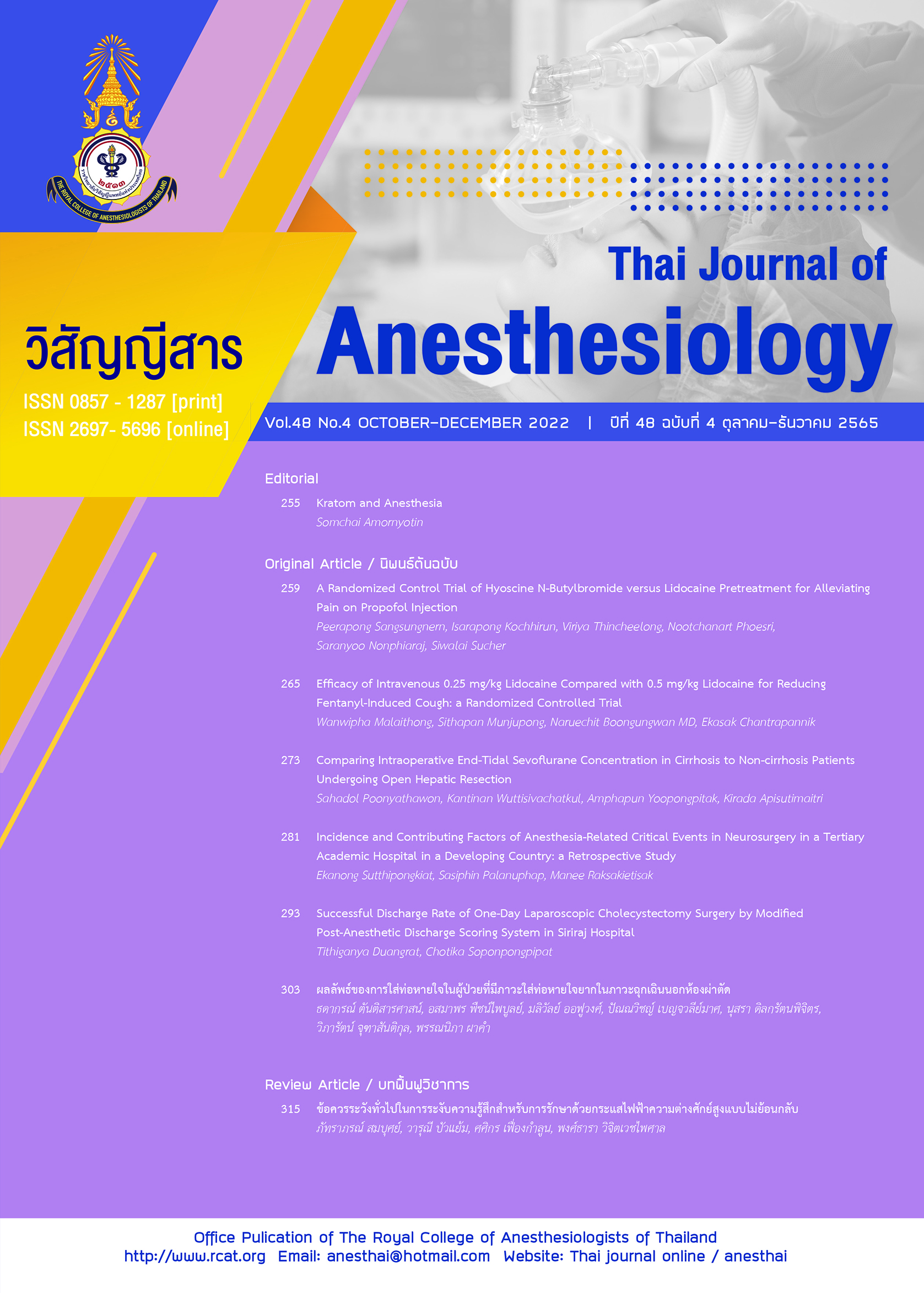Incidence and Contributing Factors of Anesthesia-Related Critical Events in Neurosurgery in a Tertiary Academic Hospital in a Developing Country: a Retrospective Study
Main Article Content
Abstract
Background and aim: Neurosurgery is regarded as high-risk surgery due to comorbidities of patients, urgency and complexities of procedures. Mostly, reported complications were surgical-related complications. Very few studies reported anesthesia-related complications. This study aims to determine the incidence and contributing factors of anesthesia-related complications in neurosurgical unit. Methods: Total 12,418 patients of this retrospective study had neurosurgical procedures during 7 years (2014-2020). Every incident report would be extensively reviewed by 3 investigators to classify the contributing factors of complications together with severities and outcomes. The immediate (first 24 hours) and delayed (7 days) outcomes were recorded. The outcomes were classified as complete recovery, prolonged ventilation, prolonged hospital stay, vegetative state and death. The descriptive analysis was used for the outcome. Results: There were 214 incidents of 184 patients per 12,418 anesthetics or 1.7%. Top five complications were lip trauma (53 events, 28.8%), difficult intubation (36 events, 19.6%), reintubation (23 events, 12.5%), dental injury (18 events, 9.8%), esophageal intubation (15 events, 8.2%). Top three contributing factors were inexperience (38.4%), inappropriate decision (17.8%) and patient factor (15.5%). Major complications such as death, cardiac arrest, stroke and convulsion were found in 23 cases, mostly related to patient factor, surgical factor and inappropriate decision. Nearly half (n=91, 44%) had complete recovery during immediate postoperative period. Conclusion: Airway complications were the most anesthesia-related complications in neuroanesthesia and the most contributing factor was inexperienced trainee. Attention should be focused on improving in-training in airway management and developing protocols to minimize human and system errors.
Article Details

This work is licensed under a Creative Commons Attribution-NonCommercial-NoDerivatives 4.0 International License.
References
Siqueira EM, Diccini S. Postoperative complications in elective and non-elective neurosurgery. Acta Paulista de Enfermagem. 2017;30:101-8.
Rock AK, Opalak CF, Workman KG, Broaddus WC. Safety outcomes following spine and cranial neurosurgery: evidence from the National Surgical Quality Improvement Program. J Neurosurg Anesthesiol. 2018;30:328-36.
Westerkamp AC, de Geus AF, Molenbuur B, et al. Comparing peri-operative complications of paediatric and adult anaesthesia. Eur J Anaesthesiol. 2018;35:280-8.
Aleksic V, Radulovic D, Milakovic B, et al. A retrospective analysis of anesthesiologic complications in pediatric neurosurgery. Pediatr Anesth. 2009;19:879-86.
Tuchinda L, Punjasawadwong Y, Ittichaikulthol W, Raksakietisak M, Tongrong C, Sangtongcharaskul S. Perioperative and Anesthetic Adverse Events in Thailand (PAAd Thai) Study Database: Neuroanesthesia. J Med Assoc Thai. 2020;103:686-94.
Solheim O, Jakola AS, Gulati S, Johannesen TB. Incidence and causes of perioperative mortality after primary surgery for intracranial tumors: a national, population-based study. J Neurosurg. 2012;116:825-34.
Quinn TD, Brovman EY, Aglio LS, Urman RD. Factors associated with an increased risk of perioperative cardiac arrest in emergent and elective craniotomy and spine surgery. Clin Neurol Neurosurg. 2017;161:6-13.
Charuluxananan S, Sriraj W, Punjasawadwong Y, et al. Perioperative and Anesthetic Adverse events in Thailand (PAAd Thai) incident reporting study: anesthetic profiles and outcomes. Asian Biomed. 2017;11:21-32.
Gupta S, Naithani U, Brajesh SK, Pathania VS, Gupta A. Critical incident reporting in anaesthesia: a prospective internal audit. Indian J Anaesth. 2009;53:425.
Farshad M, Bauer DE, Wechsler C, Gerber C, Aichmair A. Risk factors for perioperative morbidity in spine surgeries of different complexities: a multivariate analysis of 1,009 consecutive patients. Spine. 2018;18:1625-31.
Schiff JH, Welker A, Fohr B, et al. Major incidents and complications in otherwise healthy patients undergoing elective procedures: results based on 1.37 million anaesthetic procedures. Brit J Anaesth. 2014;113:109-21.
Pian-Smith MCM, Simon R, Minehart RD, et al. Teaching residents the two-challenge rule: a simulation-based approach to improve education and patient safety. Simul Healthc. 2009;4:84-91.
Heidegger T. Management of the difficult airway. N Engl J Med. 2021;384:1836-47.
Souter MJ, Manno EM. Ventilatory management and extubation criteria of the neurological/neurosurgical patient. Neurohospitalist. 2013;3:39-45.
Hinkelbein J, Andres J, Thies KC, DE Robertis E. Perioperative cardiac arrest in the operating room environment: a review of the literature. Minerva Anestesiol. 2017;83:1190-8.
Anastasian ZH. Anaesthetic management of the patient with acute ischaemic stroke. Br J Anaesth. 2014;113(Suppl2):ii9-16.
Attri JP, Makhni R, Chatrath V, Bala N, Kumar R, Jain P. Perioperative death: its implications and management. Saudi J Anaesth. 2016;10:436.
Al-Elq AH. Simulation-based medical teaching and learning. J Family Community Med. 2010;17:35-40.
Chen DY, Chen CC, Crawford JR, Wang SG. Tumor-related epilepsy: epidemiology, pathogenesis and management. J Neurooncol. 2018;139:13-21.


